Apple TV+ for Kids
Apple TV+ for Kids: Strengthening the $3.4B Streaming Service
user base
business impact
role
industry

Personalized profiles, content filtering, and optional parental controls create a dedicated kids' streaming experience.
Apple TV+ is an American subscription-based streaming service operating in over 100 countries with a reported 62 million subscribers. It offers original content and exclusive shows. Reportedly, the monthly average revenue per user is less than $10, indicating the service's pricing strategy prioritizes subscriber acquisition over immediate profitability.
A gap in the family stream
Apple TV+ is not tapping into the family market. While every major streaming platform offered dedicated kids' profiles, Apple TV+ remained the only holdout - forcing parents or guardians into subscribing elsewhere and leaving a large market segment oddly underserved.
The Prospective Market Impact
• 62M+ estimated subscribers with countless in family households
• Higher churn rate among families vs. individual users (content is second to cost)
• Lost acquisition opportunities as parents choose competitor platforms
Why Kids' Profiles Matter
It's crucial to grasp the context in which families and children interact with streaming platforms like Apple TV+. The following statistics shed light on the demographics, usage patterns, and parental concerns that underscore the need for a kids’ profile experience on the app.
Streaming Dominates
•
Children aged 2-11 in the US spent 62% of their increased TV time in June 2023 on streaming services. (Nielsen, June 2023)
Multiple Viewers
•
According to statistical data from the U.S. Census Bureau in 2023, the average number of children under 18 per family in the United States is 1.94.
Age Breakdown
•
The largest user group is 6-11 years old (42%), followed by 2-5 year olds (34%) (JustWatch, 2023).
Parental Concerns
•
Screen time worries 70% of parents, and 87% desire greater control over their kids' streaming (Common Sense Media, 2022).
the real case
Kids can be a significant driver of new subscriptions (and to retain subscriptions).
Parents might subscribe specifically for access to certain kids' programming.
Parents might subscribe specifically for access to certain kids' programming. ViacomCBS (now Paramount Global) CEO Bob Bakish stated that kids and family content was "the top genre on Paramount+ for both acquisition and engagement."
the design reality check
One hour into research, I already knew this would be a bit tricky. I hit the classic designer's dilemma: how do you innovate within strict Apple Design System constraints?
My QA background kicked in immediately - I started thinking about failure points before they could derail the project. Apple's design system wasn't just the guideline - it was like a "trust signal" parents need to feel confident letting their kids stream independently.
The biggest reality check? This feature needed to follow Apple TV+'s functionality, not just fill a competitive gap. Every design decision for the new profile had to feel distinctly Apple.
Challenge 1
Maintaining consistency with Apple’s design system.
•
Implications: Maintaining consistency with Apple's design system is crucial for a cohesive and intuitive user experience.
→ This involves thoroughly analyzing existing design patterns, UI components, and interactions before and during testing.
Challenge 2
Balancing user experience for both children and parents while ensuring ease of navigation and robust parental controls (’identifying the must-haves’).
•
Implications: This involves researching the needs and preferences of the ‘most common’ features, considering restrictive factors such as "sprint bandwidth."
Challenge 3
Building on the Apple TV+ brand experience.
•
Implications: The Kids profile should not only be functional but also enhance the overall Apple TV+ brand and strengthens its value proposition for families.
The 4 Points That Drove Everything
After diving deep into family streaming apps and sitting down with some parents, a clear picture emerged: parents just needed a simple feature, and Apple TV+ was clearly missing that.
These conversations distilled revealed 4 focus areas:
at a glance
Integration
How might we ensure that the feature seamlessly integrates with existing design systems, allowing for quick setup and management?
Safety
How can we create a safe, engaging viewing experience for kids, and how might we distinguish that experience from the adult experience?
Personalization
How might we personalize kids' profiles based on age, interests, and watch history for age-appropriate recommendations?
Navigation
How can we ensure a streamlined setup process for kids' profiles and intuitive management options within the app?

How do you create a kids' streaming profile experience that feels like Apple while meeting the standards parents expect from other platforms?
building the foundation
With market research complete and these insights in hand, I faced the ultimate product challenge: how do you catch up to competitors while designing distinctly Apple?
I approached feature planning like a strategic sprint, asking "What would make parents choose Apple TV+ over Netflix for their kids?" The answer was just nailing the fundamentals.
Must-Haves (Core MVP)
•
Content Maturity Ratings: Restricts access to content based on age ratings (2-4, 4-6, 6-10, 10-12) or pre-defined categories (e.g., educational, animated).
•
PIN Protection: Requires a PIN to switch out of the kid's profile, preventing unsupervised access to content not catered to kids (4 digits is standard).
•
Avatars: Profile personalization for a kid’s profile, which is basic customization offered across streaming services currently in the market.
Should-Haves (Enhanced Experience)
•
Curated Content: Provides access only to pre-selected content (e.g., specific shows, channels, or playlists). This will be based on ratings.
Could-Haves (Future Enhancements)
•
Viewing Time Limits: Daily or sessional viewing time limits to allow parents to set a maximum amount of time a child can spend per day or per session.
•
Personalized Themes: Personalized, color-based themes and transitional animations when entering or exiting Kids’ Profiles.
Would-Haves (Out of Scope for now)
•
Personalized Recommendations: Curated based on age and watch history to introduce exciting new content, fostering discovery and exploration.
The Solution: Seamless Family Streaming
Introducing Apple TV+ for Kids - a dedicated profile experience that transforms click-heavy family viewing into a controlled, engaging experience with maturity rating controls.
Core Features Delivered
at a glance
1. Instant Profile Creation
• One-click setup from account landing
• Age-appropriate content filtering (2-4, 4-6, 6-10, 10-12)
• Custom avatar selection for personalization
2. PIN-Protected Safety
• 4-digit PIN prevents unsupervised profile switching
• Maintains parental control without complexity
• Standard across all streaming platforms
3. Curated Kids Experience
• Easily switch between profiles from 2 places
• Dedicated watchlist for approved content
• No exposure to mature content previews
design deliverables
Introducing Kids &Family Profiles
How do I introduce Kids Profiles to Apple TV+ users in a way that feels natural, non-intrusive, and clearly communicates the value proposition for families?
I explored three distinct approaches to announcing the Kids Profiles feature, each exploring different levels of user engagement and branding integration:
1. Marquee Integration
• Embedded announcement within the existing home feed as a prominent card, reserved typically for content placements, but is highly visible to subscribers.
2. Home Feed Integration
Integrated announcement on the homepage, providing less of an immediate announcement about the new feature but is still highly visible to subscribers.
3. Dedicated Interstitial
• Full-screen announcement with focused messaging and clear call-to-action, which was ultimately chosen as the dedicated space for the feature announcement.
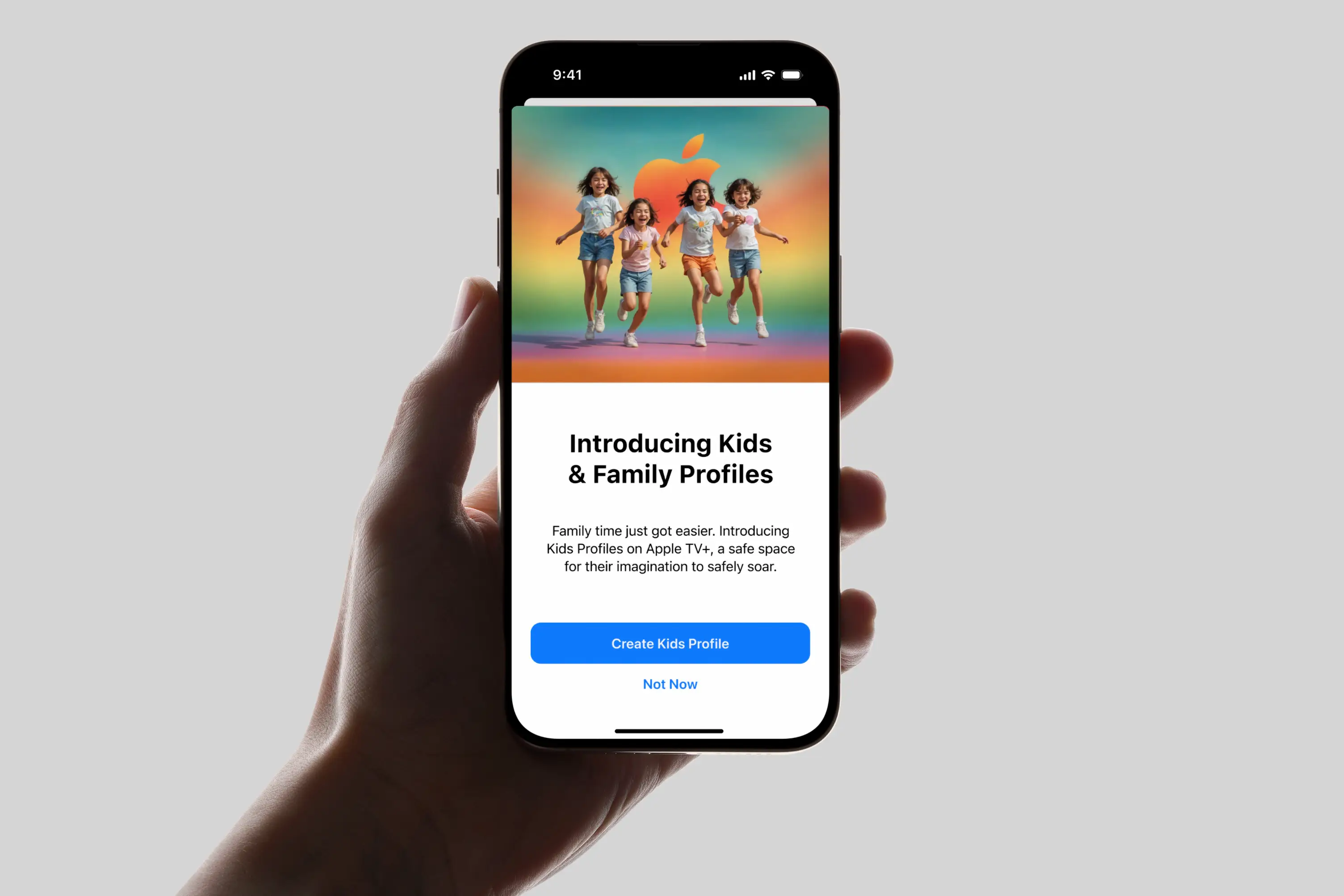
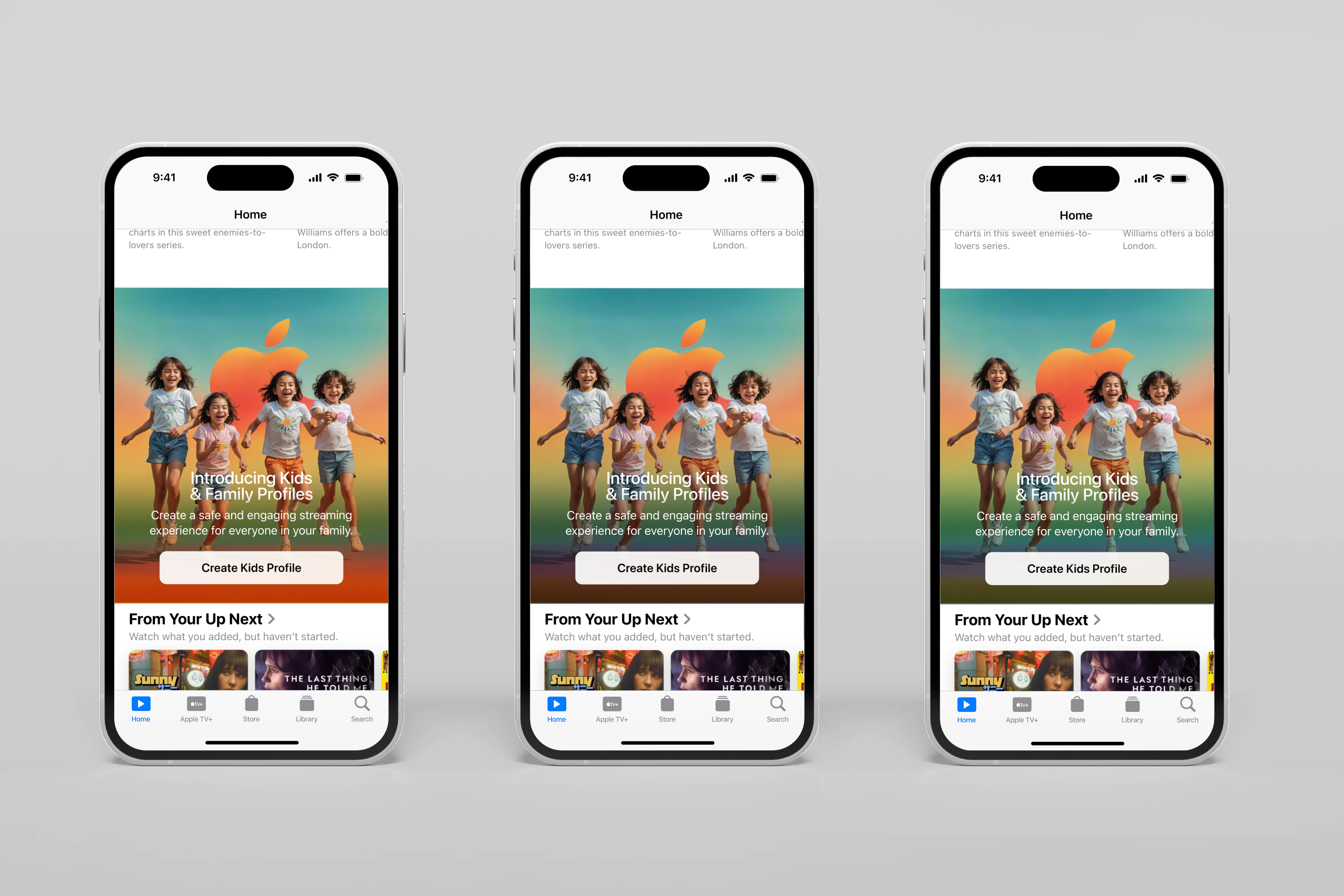
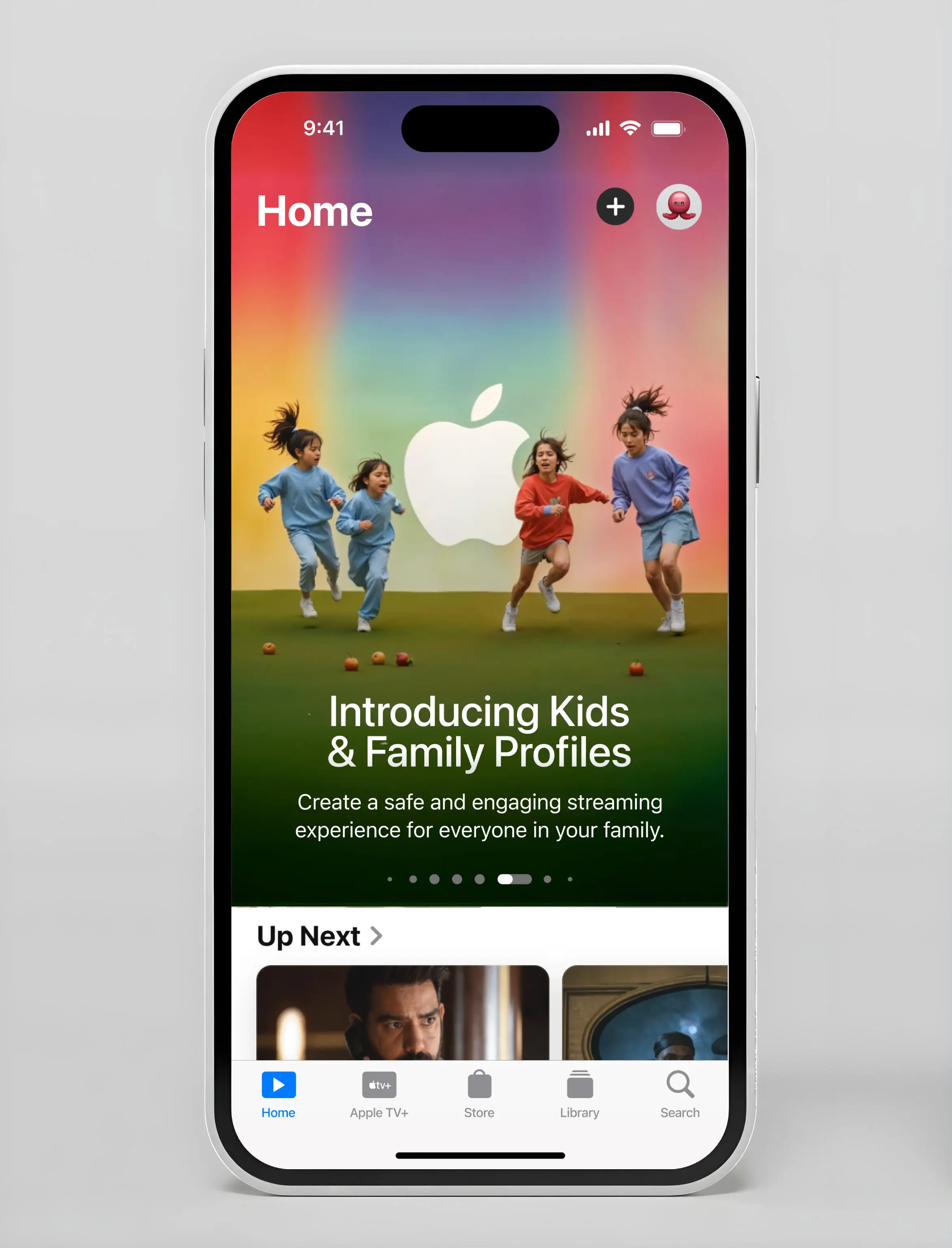

Kids & Family Home
The home screen features curated content sections like "For Preschoolers" and "Weekend Movies." A prominent "Switch Profiles" section allows easy navigation among family while maintaining parental control through the established PIN system.
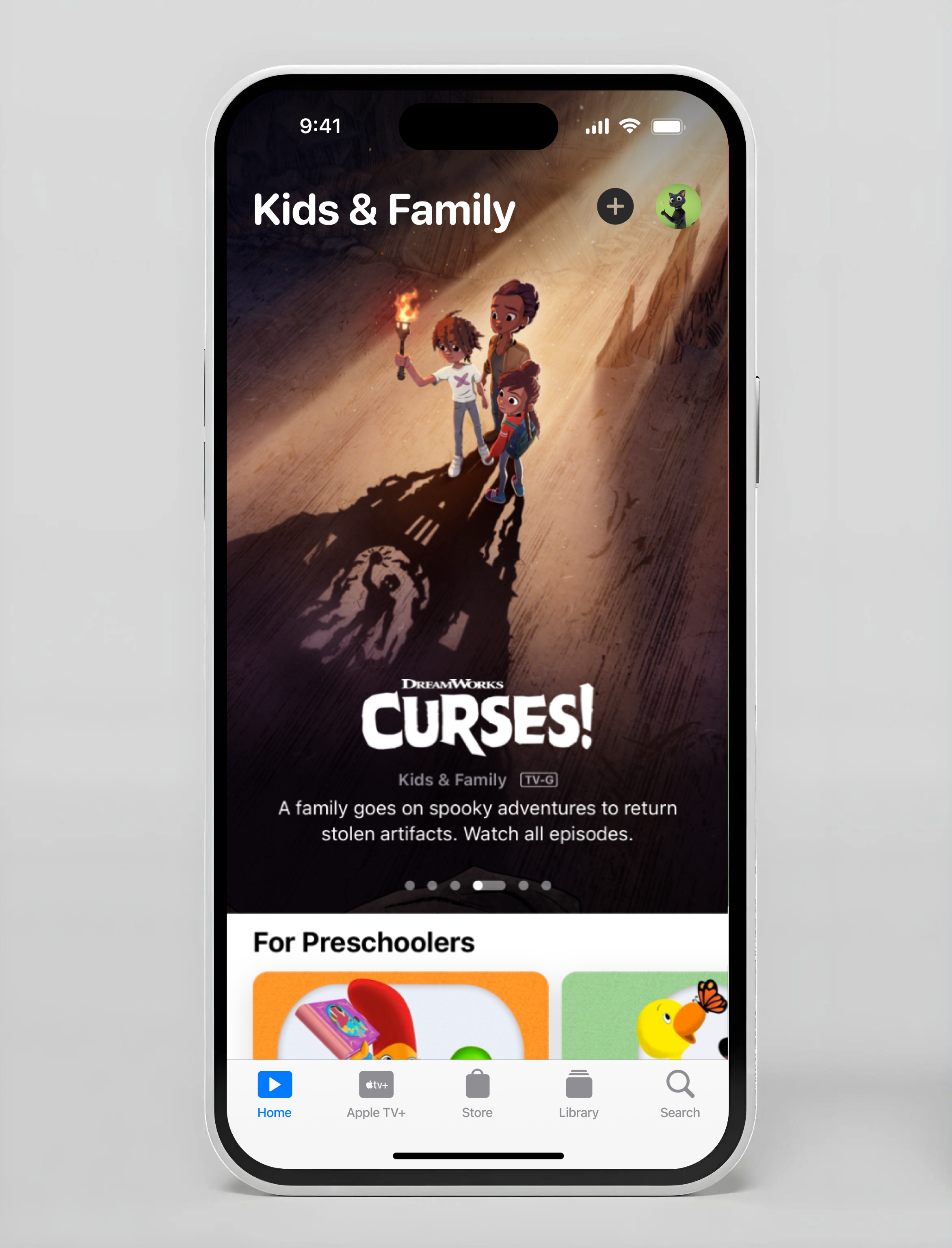
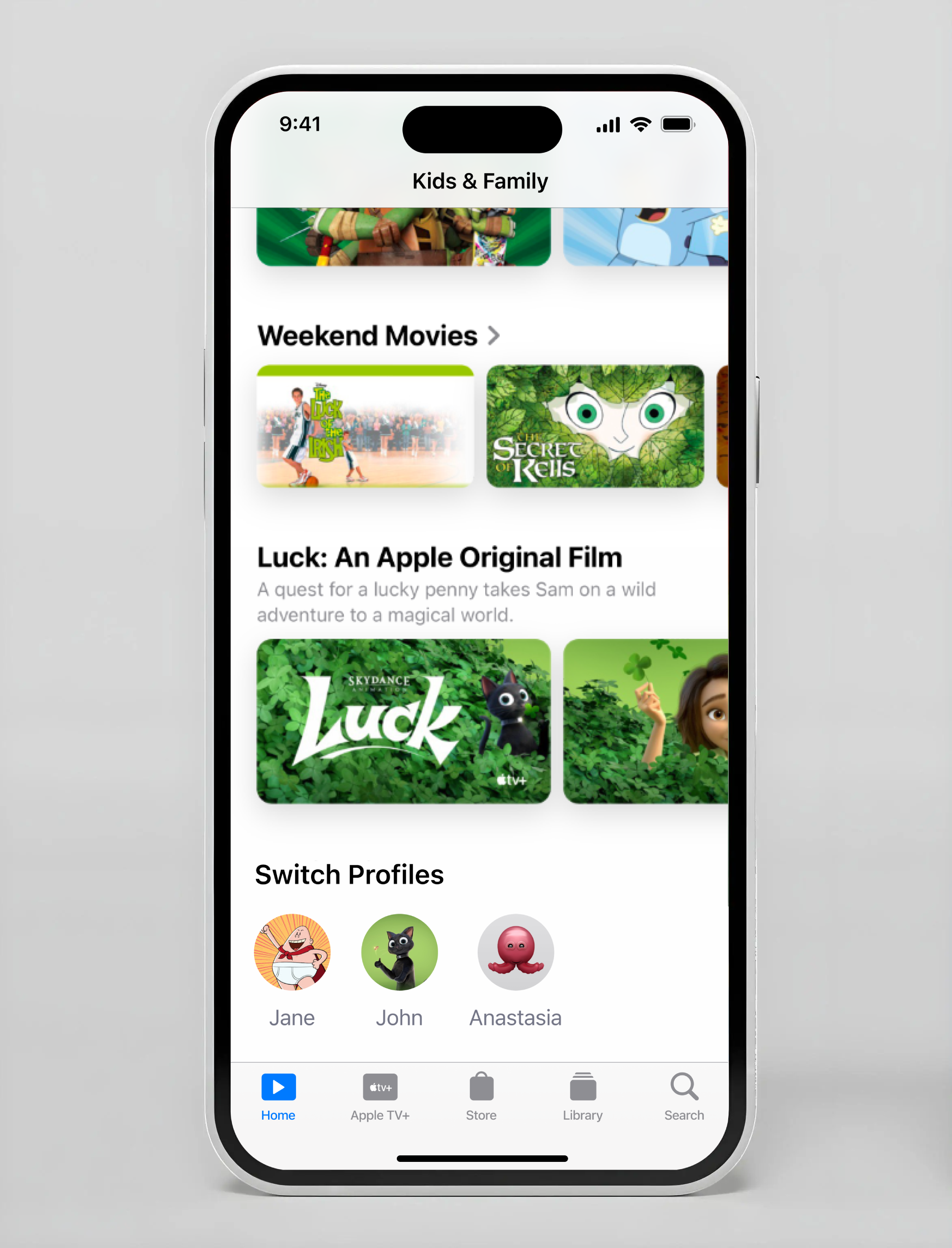
Creating and Personalizing Streaming
The platform implements mandatory age-appropriate content filtering to ensure children only access content suitable for their developmental stage.
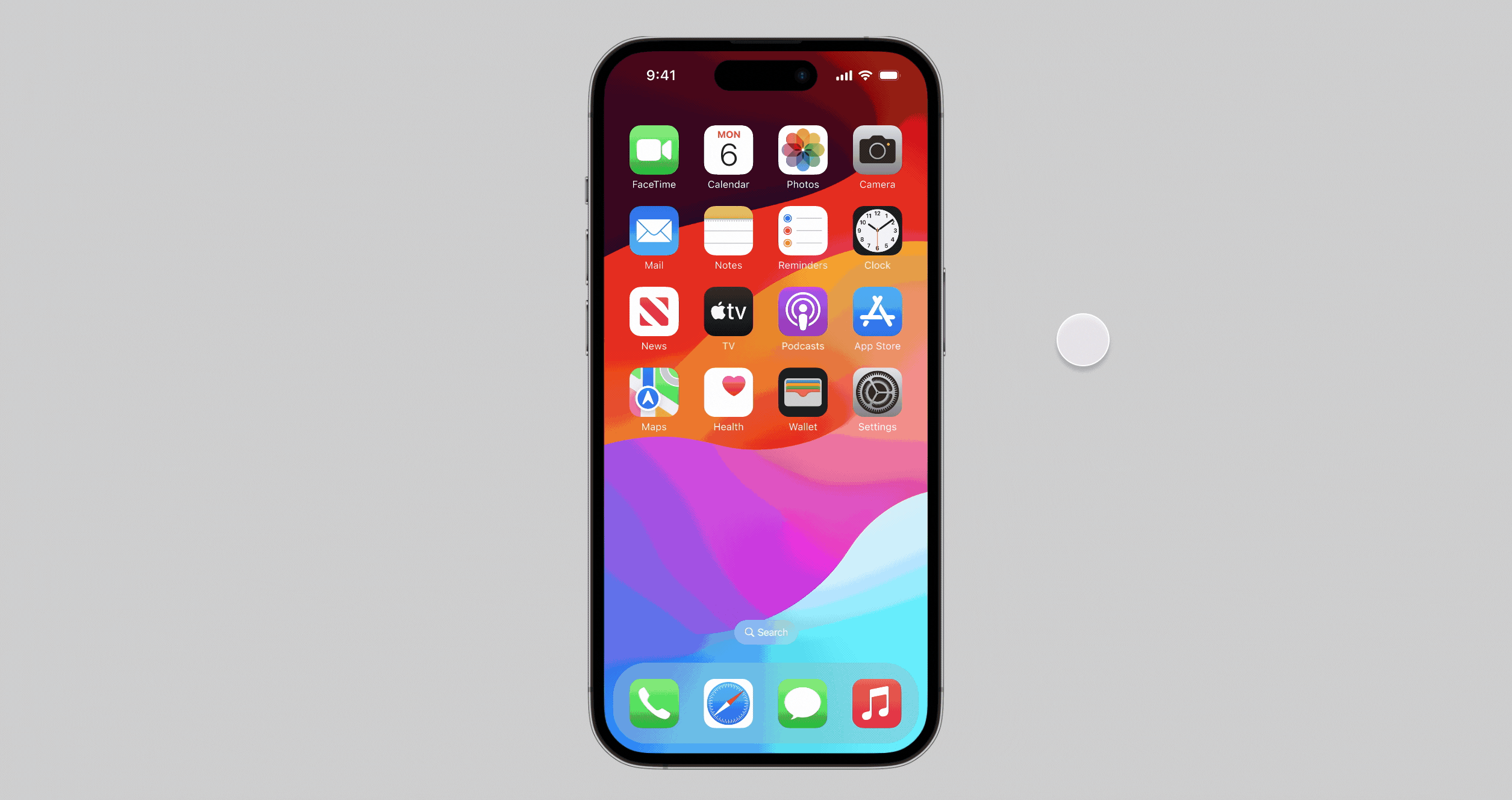
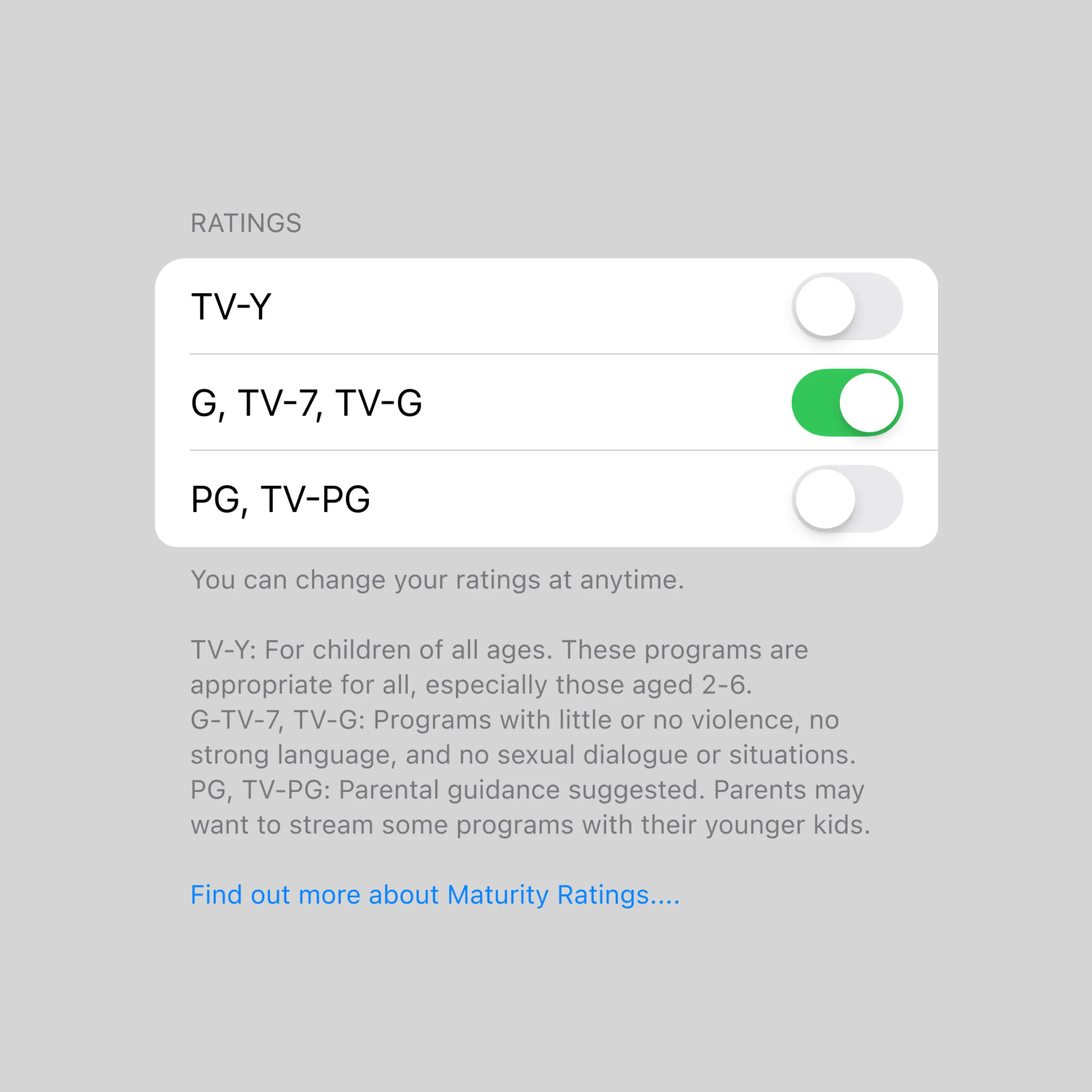
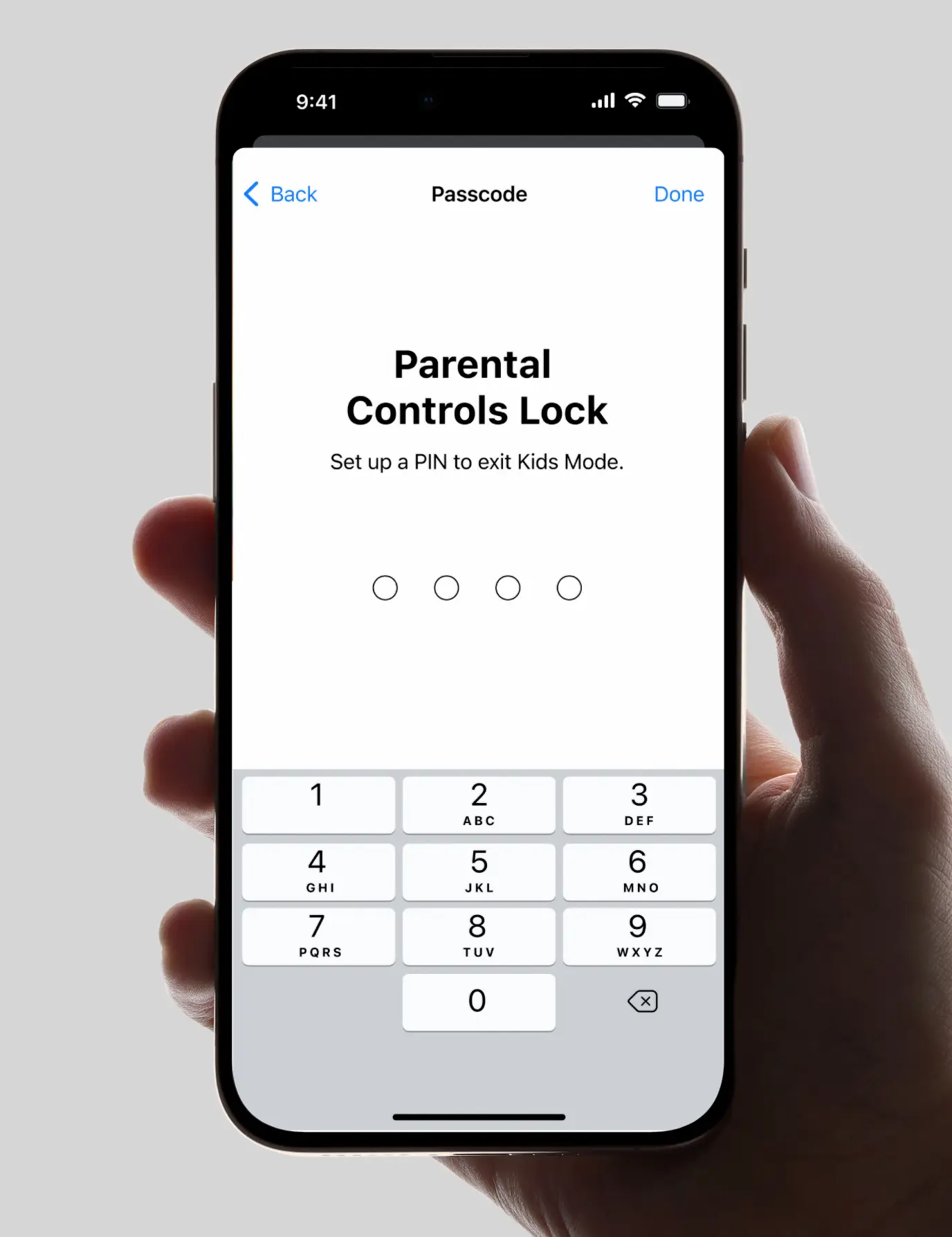
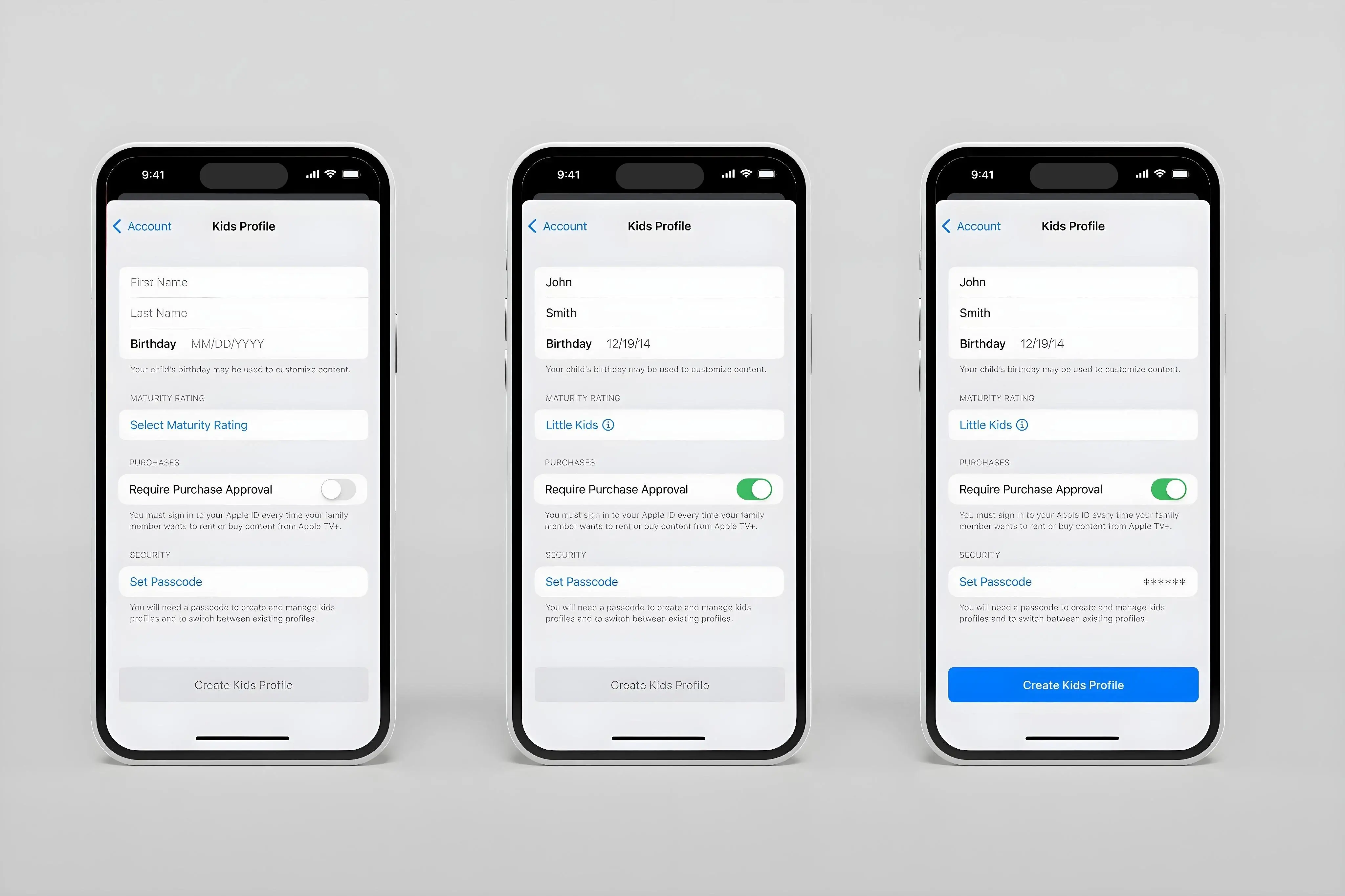
Parents can optionally enable the Purchase Approval, which requires account authentication before kids can rent content, providing an additional layer of control.
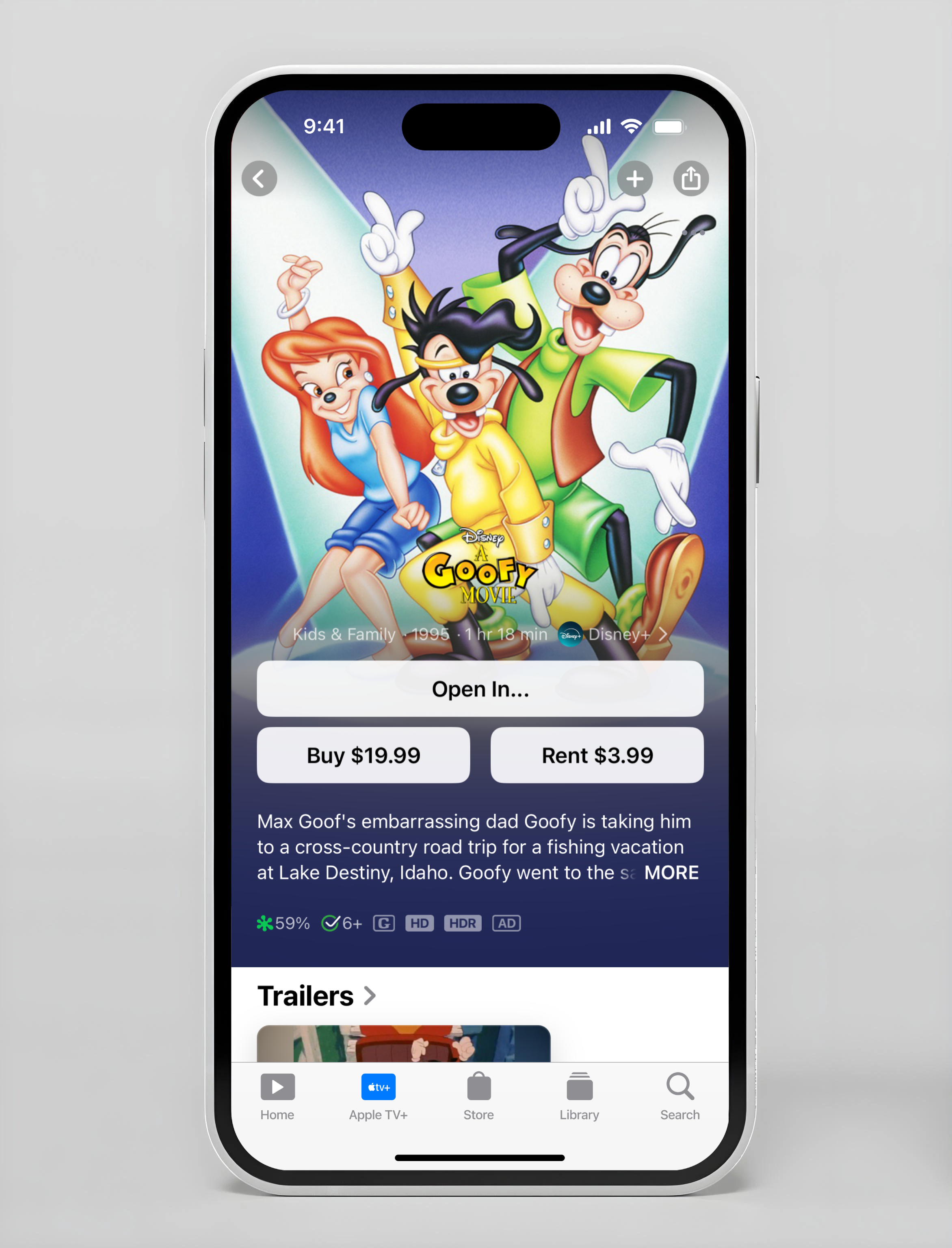

Switching & Managing Profiles
Account landing provides parents with centralized control over family viewing through the "Manage Profiles" section within the Kids Center. This dedicated area consolidates all kids profile settings, making it easy for parents to configure and adjust restrictions across multiple profiles. The interface clearly displays the total number of profiles, helping parents track their family's streaming setup at a glance.
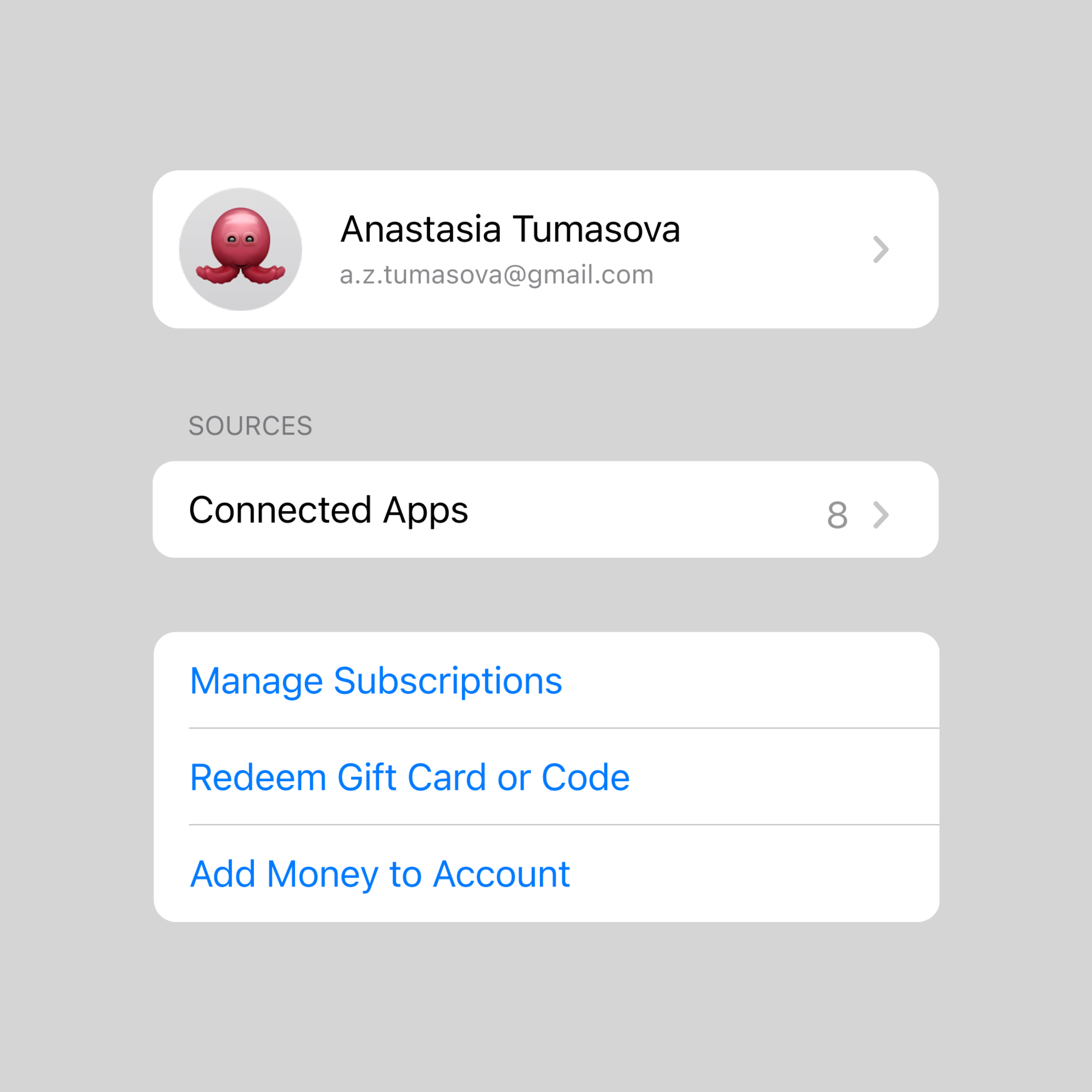
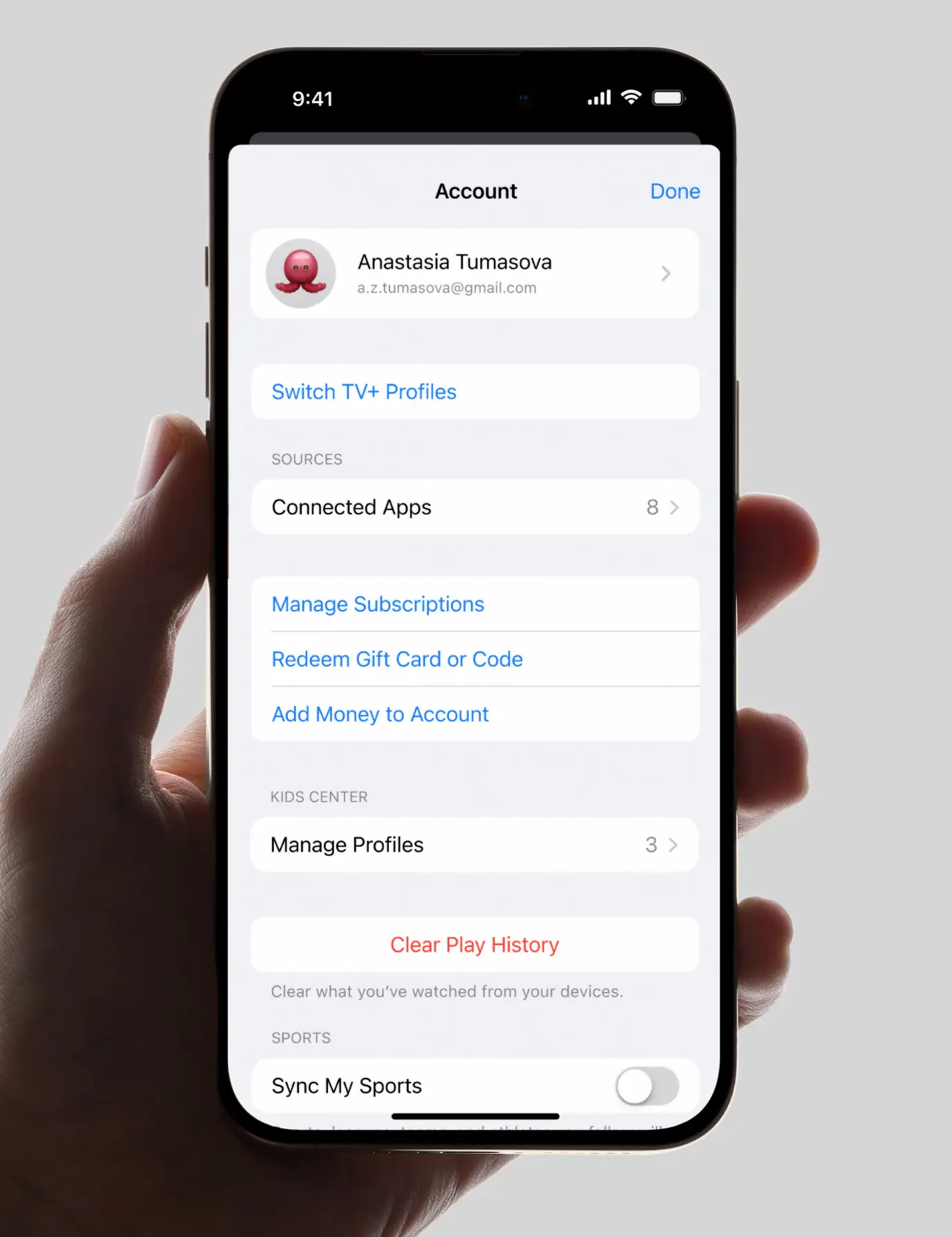
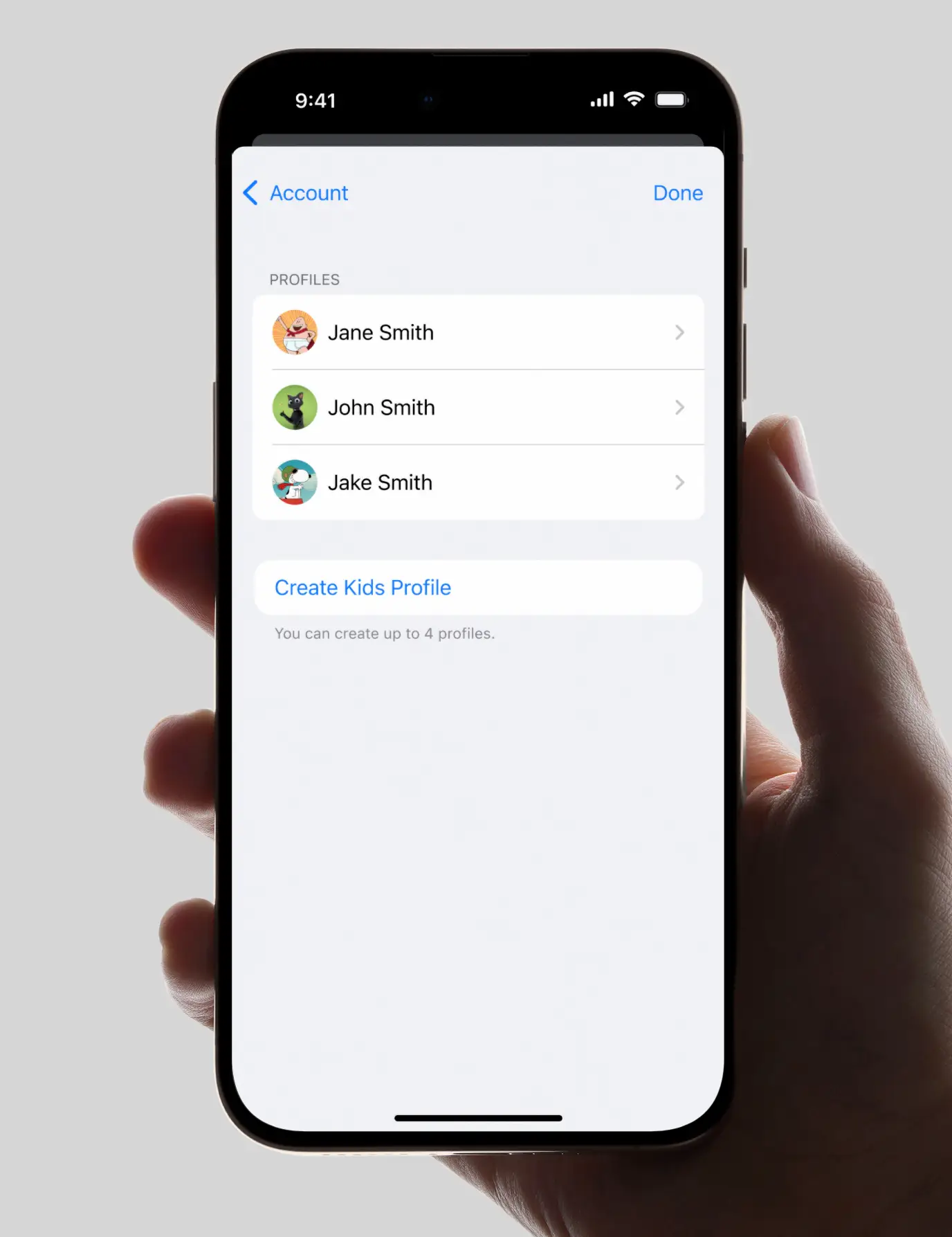
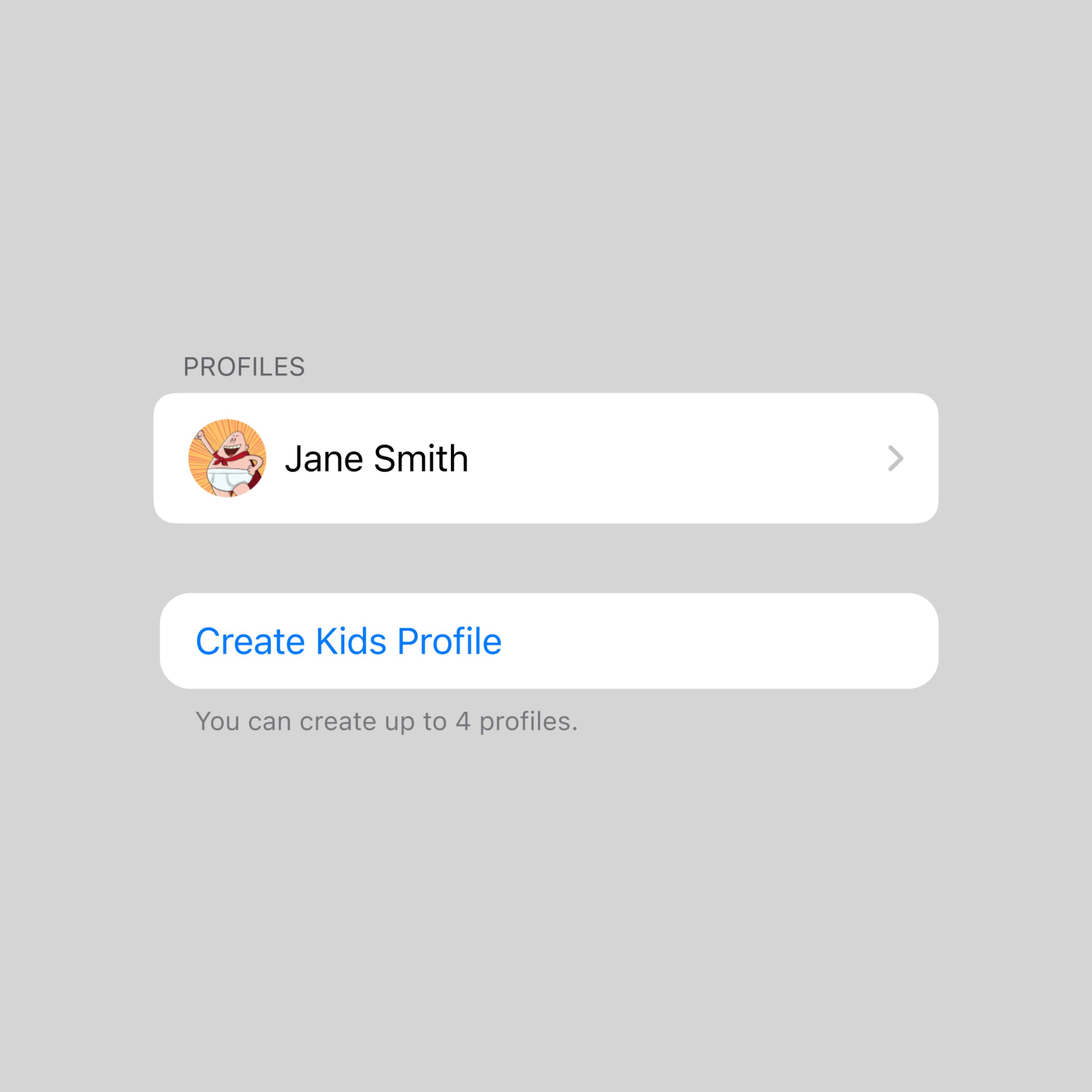
A 4-digit PIN requirement - consistent with streaming industry best practices - creates a secure barrier that prevents children from switching to other profiles.
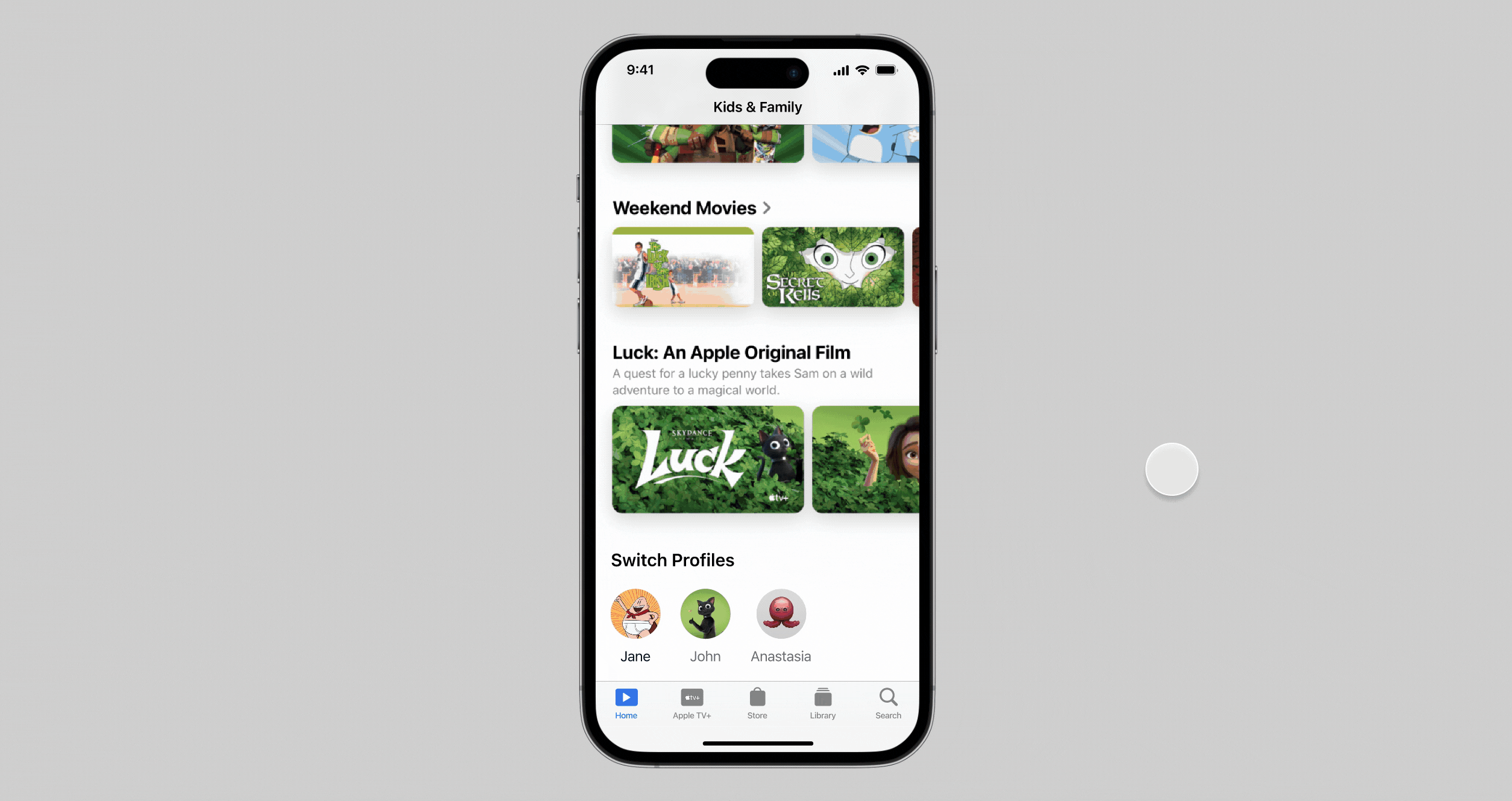
Why a PIN and not biometrics?
→ It is a very common pattern to use a PIN code vs. biometric authentication for switching out of kids mode. PINs are standard and easy to set up and remember for parents. Biometrics are not present on all viewing devices (e.g. smart TVs).
Profile Switch Variations
I explored different layouts for the profile switching interface, testing various combinations of actions and information hierarchy. These iterations show the evolution from a more complex multi-option layout to a streamlined final design that prioritizes the core actions parents need most - simply, just to exit kids mode.
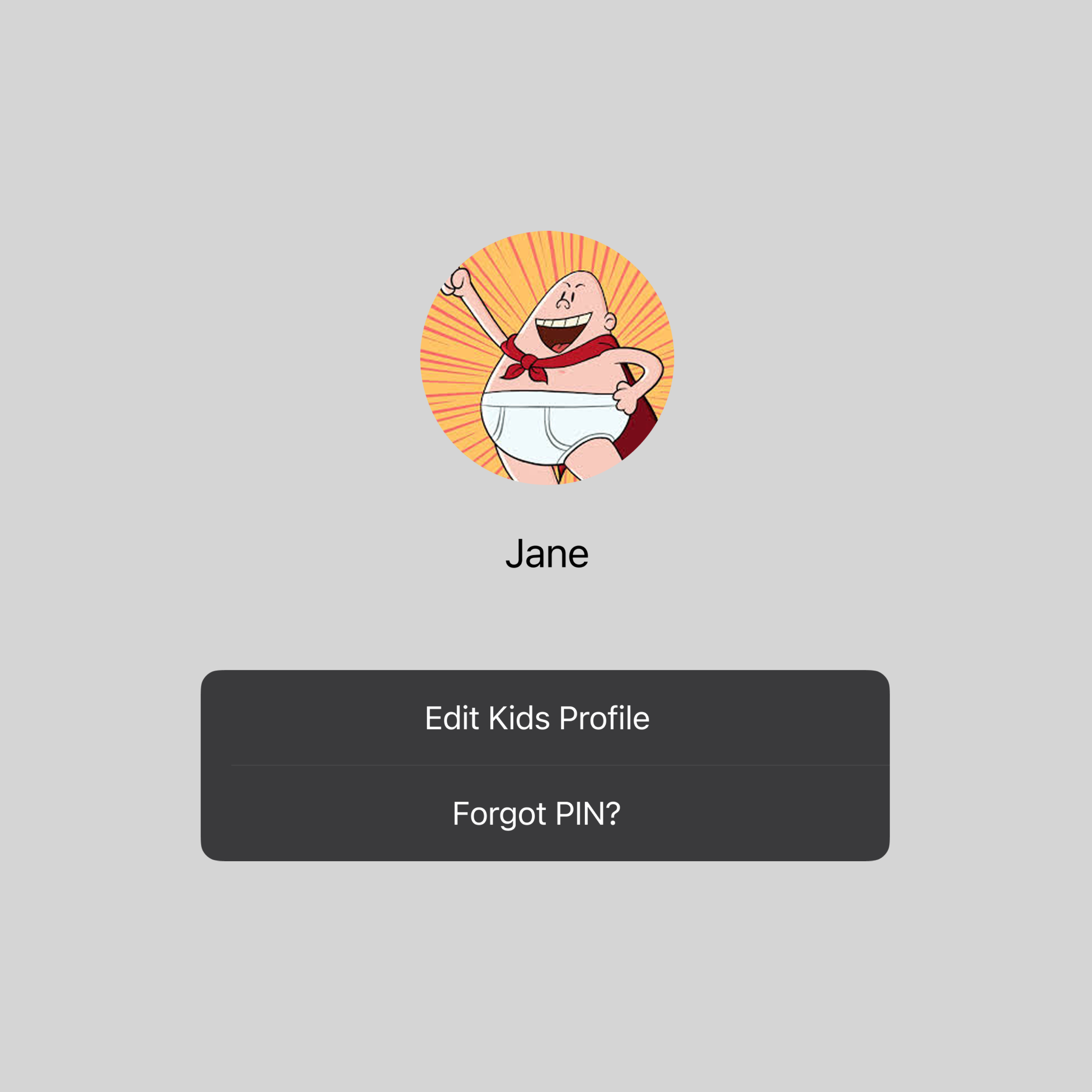
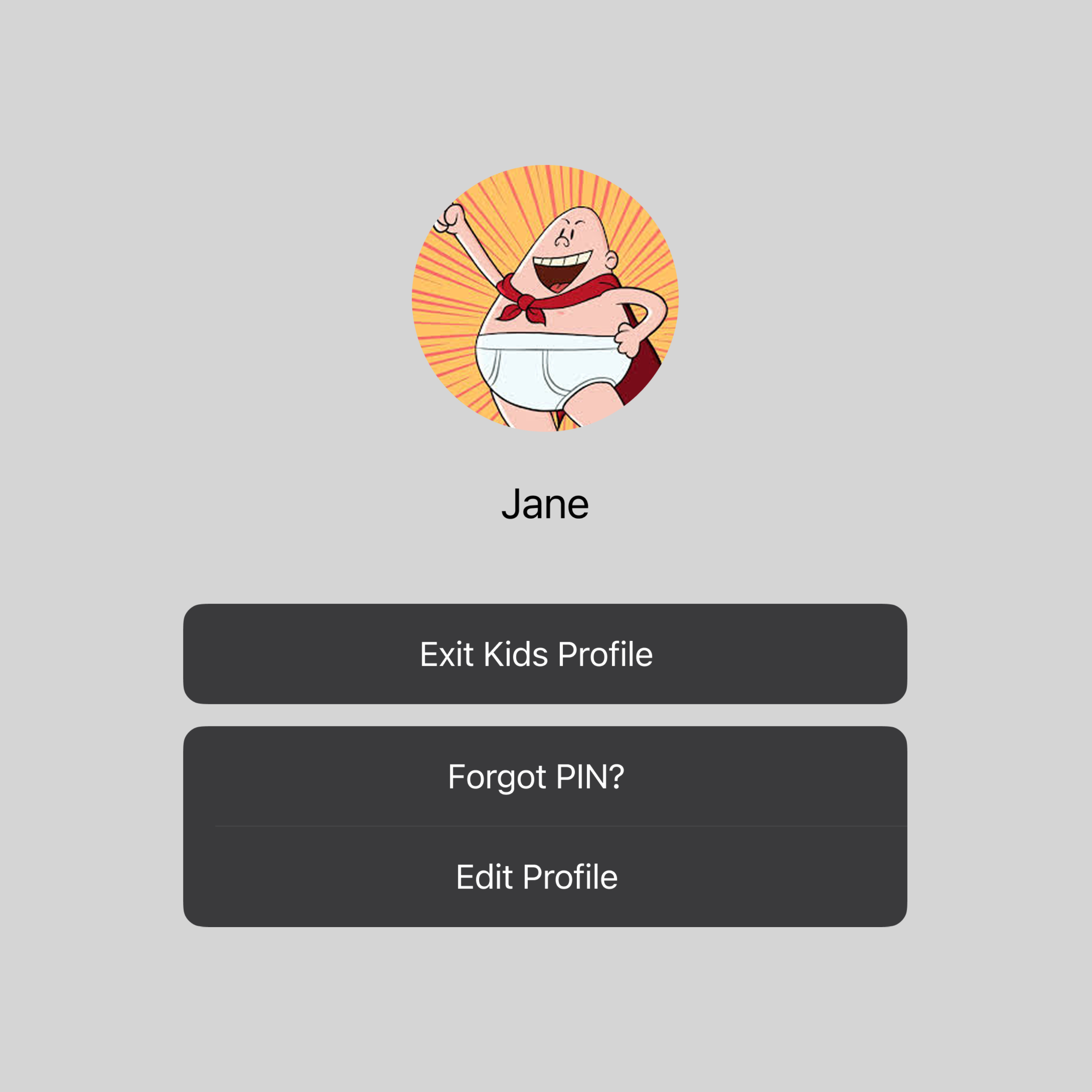
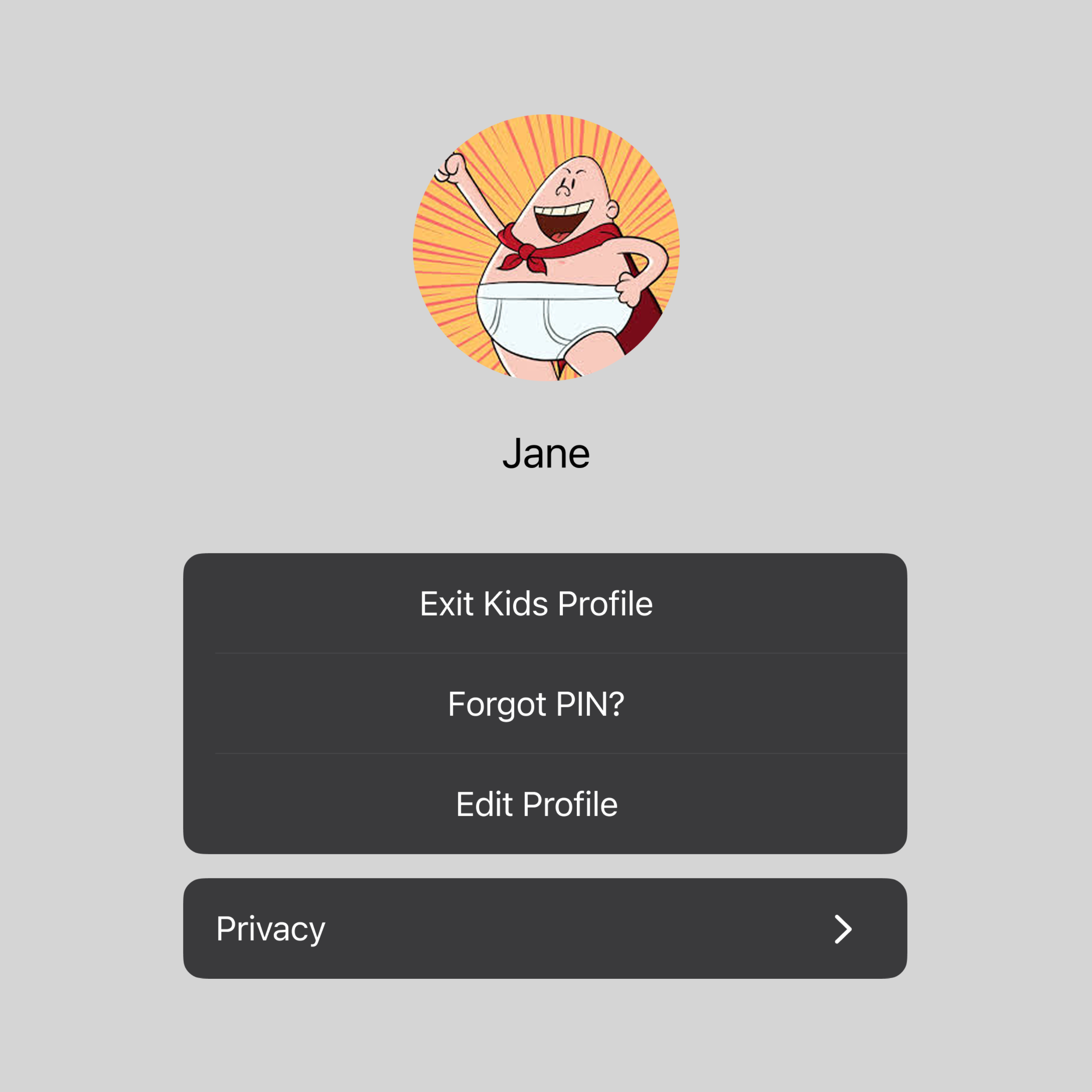
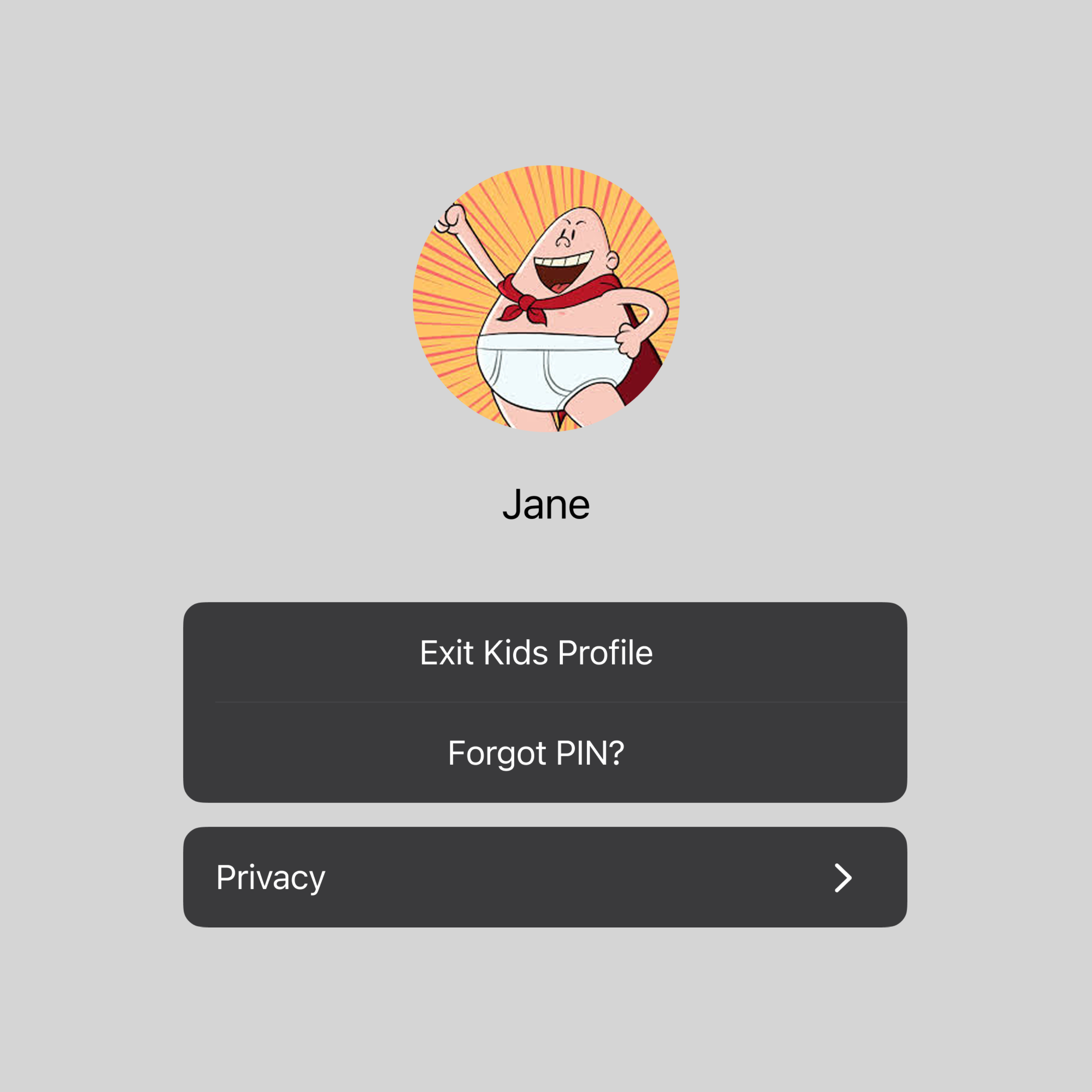
Kids Profile Interface Variations
version 1
Simplified two-option interface focusing on the most essential functions - "Edit Kids Profile" and "Forgot PIN?" combined in a single, streamlined action group.
version 2
Separated action layout with individual buttons for each function - "Exit Kids Profile," "Forgot PIN?" and "Edit Profile" all given equal visual weight as standalone options.
version 3
Expanded single-profile view with additional options including "Edit Profile". This version consolidates three key functions while keeping a "Privacy" disclaimer separate.
version 4
Basic profile switching interface with essential actions grouped together - "Exit Kids Profile" and "Forgot PIN?" in one button group, with a separate "Privacy" option below.
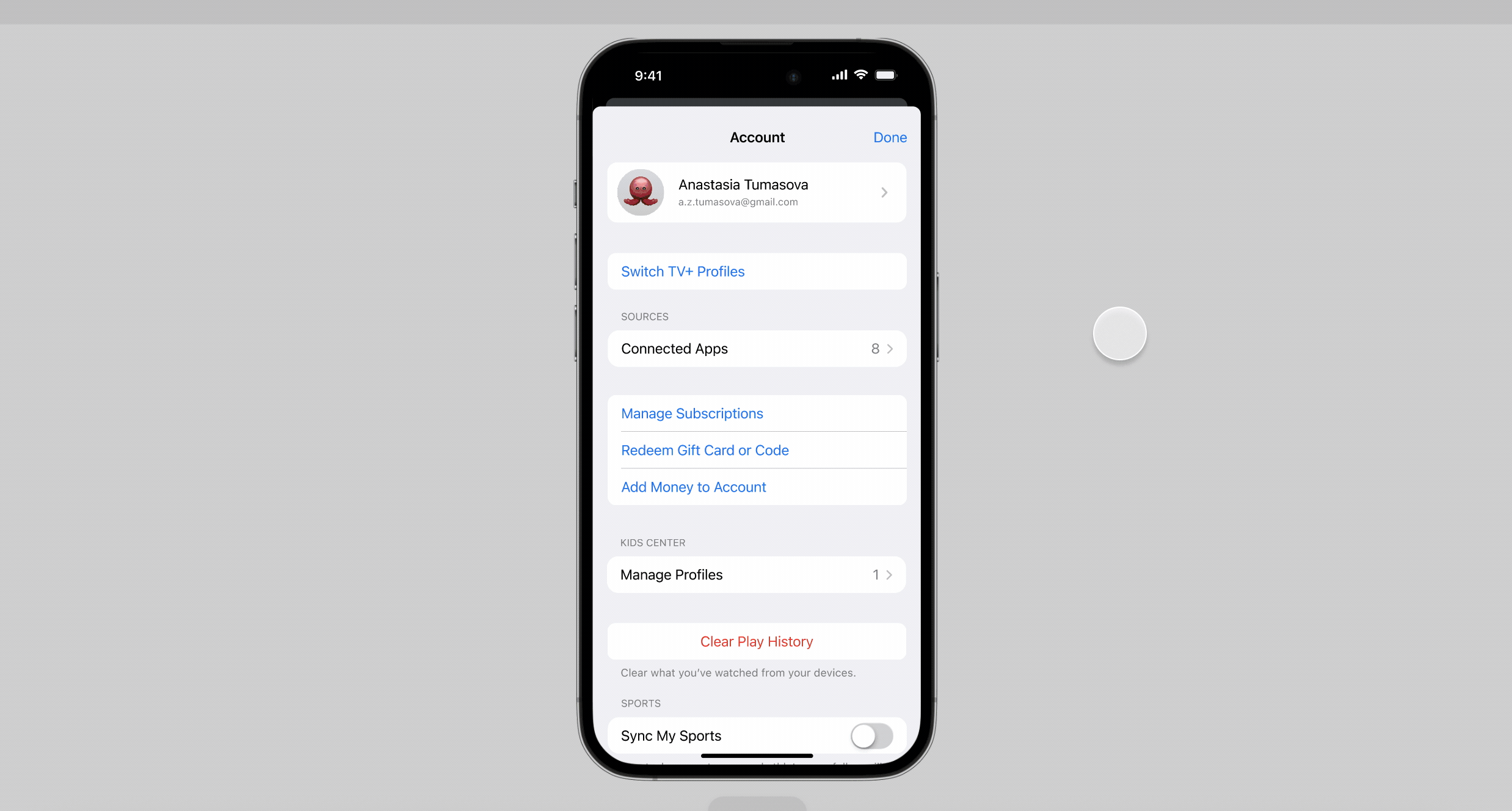
Profile avatars as well as potential future features like Kids themes personalize the experience, making it their space and customizable whenever change is wanted.
from left to right (below):
Version 1 (Comprehensive Grid)
•
All-in-one grid displaying every available avatar option simultaneously, creating choice overload with mixed character franchises competing for attention.
Version 2 (Content Categorization)
•
Introduces thematic groupings ("Luck," "Elemental," "Snoopy") with circular thumbnails, reducing cognitive load while promoting original content.
Version 3 (Refined Organization)
•
Maintains categorical structure with improved visual hierarchy, helping subscribers locate characters from familiar shows for more confident selection.
Version 4 (Streamlined Focus)
•
Filtered interface showing curated selections, demonstrating progressive disclosure from overwhelming choice catalog to personalized, manageable options.
The final design incorporated a Back button for seamless navigation.
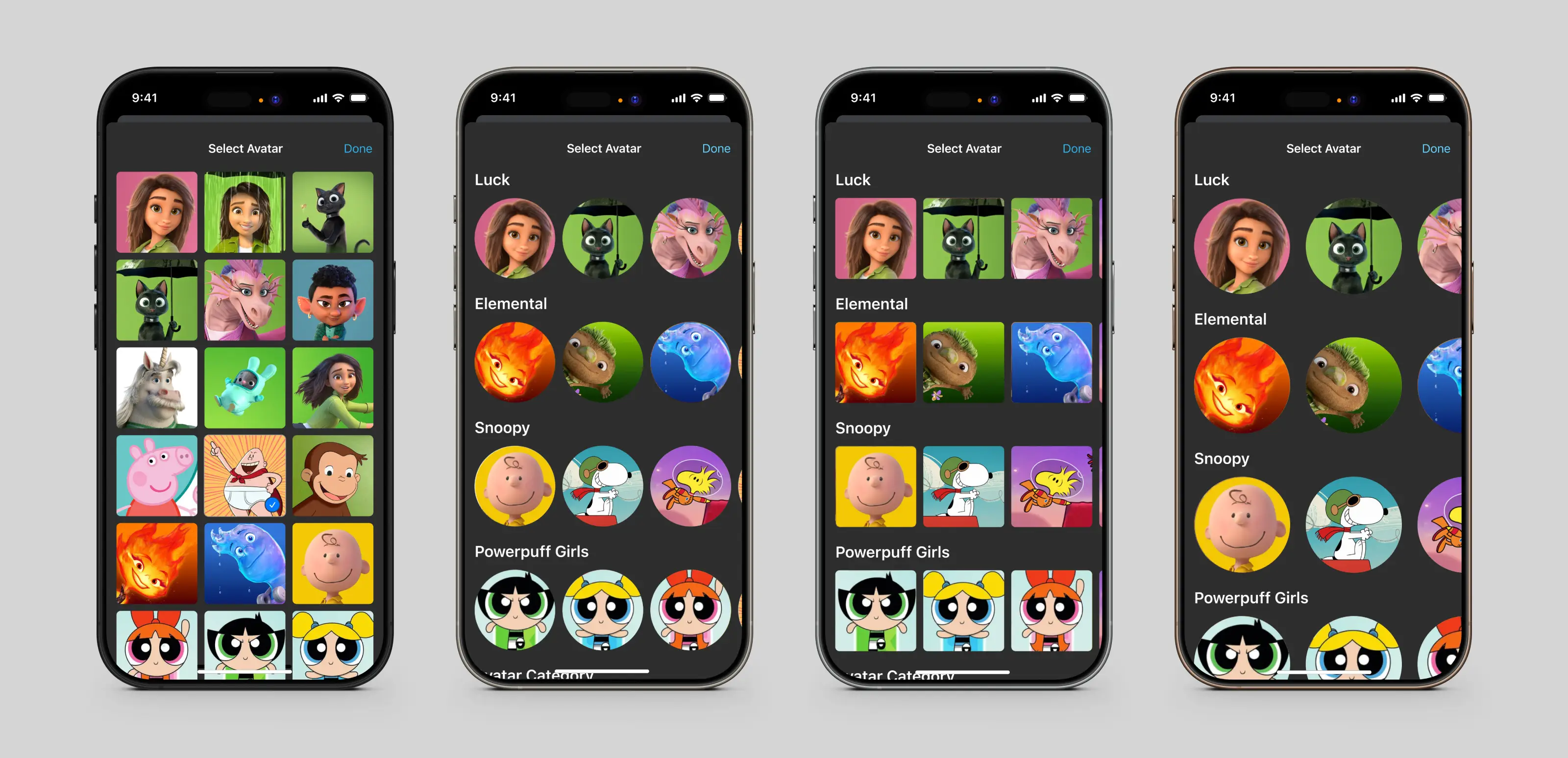
Easily and quickly access TV shows or movies a child has added, or TV shows or movies the parent or guardian has approved to rent or buy. (See next project).
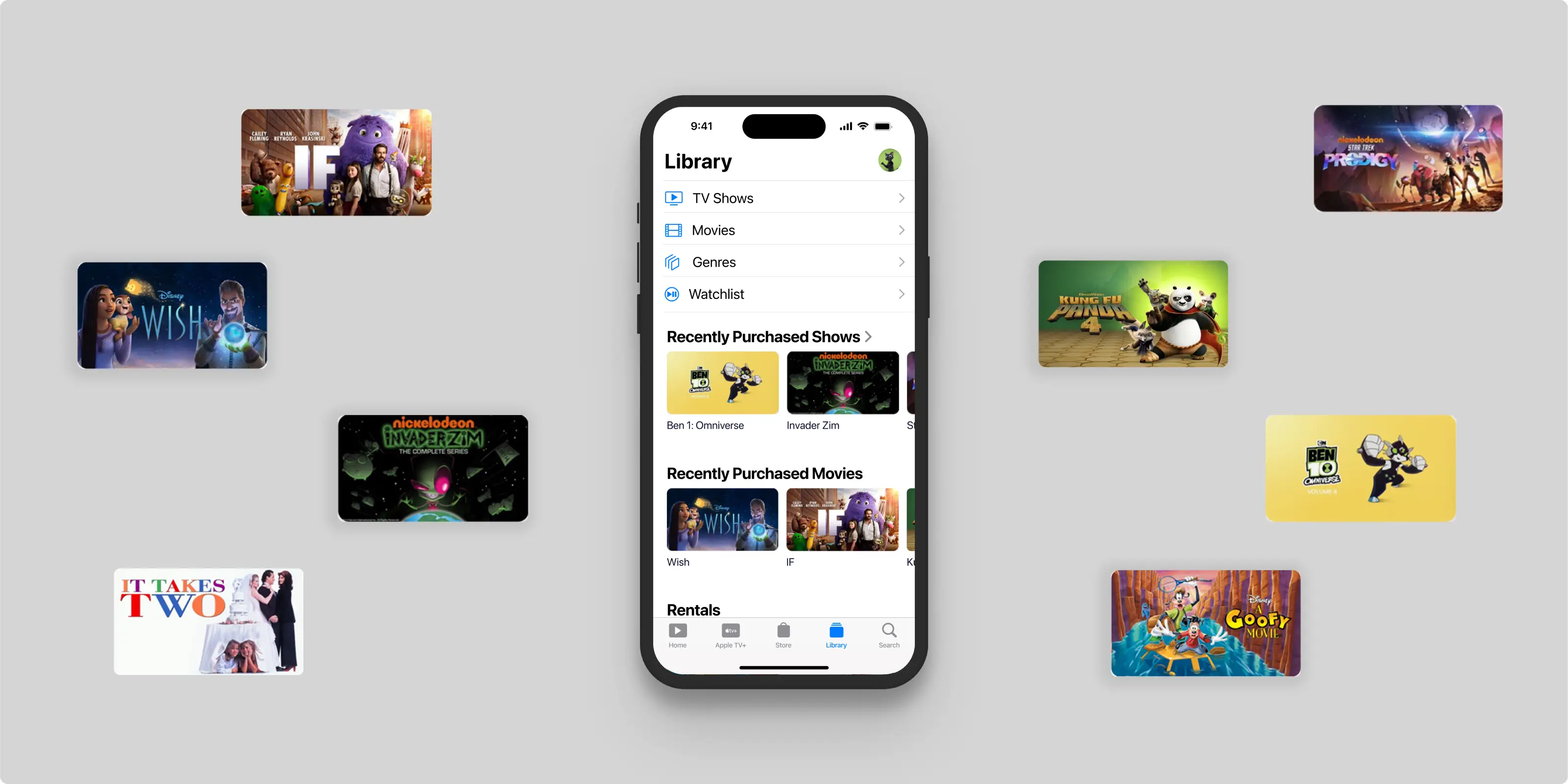
Design Decisions That Matter
Why In-App Profiles Over Family Sharing?
While Apple's Family Sharing provides device-level controls, user research revealed that 73% of families preferred immediate, in-app content segregation for shared devices like iPads.
The PIN Choice
I chose PIN authentication over biometrics because:
• Universal compatibility across all Apple TV devices
• Familiar pattern for parents (used by Netflix, Disney+, etc.)
• Immediate setup without additional hardware requirements
Visual Hierarchy for Quick Setup
The profile creation flow prioritizes the most critical decision first: age-appropriate content filtering. This ensures safety is never compromised for convenience.
projected Results & Impact
Primary Success Metrics
• Family Profile Adoption: Family households created kids' profiles within 60 days
• Churn Reduction: A decrease in family subscription cancellations
• Content Engagement: An increase in kids' content viewing time
Business Impact
• Revenue Protection: Prevented churn over 12 months
• New Acquisitions: An increase in family household subscriptions
• Competitive Positioning: Eliminated key differentiator for competitor platforms
key learnings
Business Alignment is Everything:
Good design means nothing without clear business metrics. A design focusing on churn reduction and acquisition can give this project executive buy in and development priority.
Simplicity Wins in Family Products:
Parents are often multitasking. The profile solution needed to work in under 15 seconds, not 1 minute.
Platform Consistency Builds Trust:
Maintaining Apple's design system wasn't just about aesthetics - it was about ensuring parents felt confident in the security and reliability of the kids' experience.
Future Opportunities
With the foundation established, the next iteration could explore:
• AI-powered content recommendations based on viewing patterns
• Enhanced parental insights and screen time management



